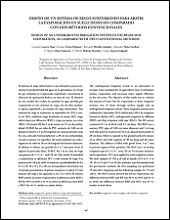DISEÑO DE UN SISTEMA DE RIEGO SUBTERRÁNEO PARA ABATIR LA EVAPORACIÓN EN SUELO DESNUDO COMPARADO CON DOS MÉTODOS CONVENCIONALES
DESIGN OF AN UNDERGROUND IRRIGATION SYSTEM TO DECREASE SOIL EVAPORATION, AS COMPARED WITH TWO CONVENTIONAL METHODS
Author
GREGORIO LUCERO VEGA
ENRIQUE TROYO DIEGUEZ
BERNARDO MURILLO AMADOR
ALEJANDRA NIETO GARIBAY
FRANCISCO HIGINIO RUIZ ESPINOZA
FELIX ALFREDO BELTRAN MORALES
SERGIO ZAMORA SALGADO
Metadata
Show full item recordAbstract
"The underground irrigation system is an alternative to increase water productivity in agriculture since it minimizes surface evaporation and increases water supply efficiency in the root zone. The objective of this study was to evaluate the amount of water lost by evaporation in three irrigation systems, two of them through surface supply and an underground irrigation system. Three irrigation systems were evaluated in, September 2015 and January 2016, by irrigation located in ditches (RZ), underground irrigation by diffusers (RSD) and drip irrigation with tape (RGC). The RZ system consisted of 1 m of ditch with 15 cm deep. The RSD was a sanitary PVC pipe of 5.08 cm inner diameter and 1 m long with side grooves located every 8.2 cm, placed horizontally at 20 cm deep, which is exposed to the ground surface by means of an elbow and tube segment of 30 cm long and the same diameter. The diffuser is filled with gravel from 3 to 7 mm to prevent ingress of fine particles. The RGC was 1 m of drip irrigation tape of 1.1 L h-1 every 20 cm. To measure moisture and evaporation, 10 L were applied to each irrigation system. We took samples of 150 g of soil at depths of 0 to 5, 5 to 10, 10 to 15 and 15 to 20 cm; moisture was determined with the gravimetric method, the first sampling was performed 15 min after irrigation and the following samples 24, 72 and 120 h. The RSD system showed the lowest evaporation; the difference between RSD and RZ was 30 % in 2015 and 41 % in 2016; the difference between RSD and RGC was 44 %, similar in both dates." "El sistema de riego subterráneo es una alternativa para incrementar la productividad del agua en la agricultura, en virtud de que minimiza la evaporación superficial e incrementa la eficiencia de aportación hídrica en zona de raíz. El objetivo de este estudio fue evaluar la cantidad de agua perdida por evaporación en tres sistemas de riego, dos de ellos mediante aporte superficial y un sistema de riego subterráneo. Tres sistemas de riego se evaluaron en septiembre de 2015 y enero de 2016, mediante riego localizado en zanjas (RZ), riego subterráneo por difusores (RSD) y riego por goteo con cinta (RGC). El sistema RZ fue 1 m de zanja con 15 cm de profundidad. El RSD fue un tubo de PVC sanitario de 5.08 cm de diámetro interior y 1 m de longitud con ranuras laterales cada 8.2 cm, colocado horizontalmente a 20 cm de profundidad, el cual se expone a la superficie del suelo mediante un codo y segmento de tubo de 30 cm de longitud del mismo diámetro. El difusor se rellena con gravilla de 3 a 7 mm para evitar el ingreso de partículas finas. El RGC fue 1 m de cinta de riego con goteros de 1.1 L h-1 cada 20 cm. Para medir la humedad y evaporación se aplicaron 10 L a cada sistema de riego. Las muestras de 150 g de suelo se tomaron a profundidades de 0 a 5, 5 a 10, 10 a 15 y 15 a 20 cm; la humedad se determinó con el método gravimétrico, el primer muestreo se realizó 15 min después del riego y los siguientes a 24, 72 y 120 h. El sistema RSD mostró la menor evaporación; la diferencia entre RSD y RZ fue 30 % en 2015 y 41 % en 2016; la diferencia entre RSD y RGC fue 44 %, similar en ambas fechas."
Collections
Related items
Showing items related by title, author, creator and subject.
-
PROMOCIÓN DEL PERIFITON PARA EL CULTIVO DE CAMARÓN BLANCO: HACIA UNA ACUICULTURA ECOLÓGICA
DOMENICO VOLTOLINA LOBINA; JUAN MANUEL AUDELO NARANJO; MARIA DEL ROSARIO PACHECO MARGES -
Suelo y Erosión
YOLANDA LOURDES MAYA DELGADO


